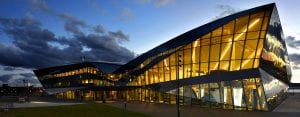Delivering for impact and the future
If this strategy is delivered in line with recommendations, by 2032 the tri-LEP region will deliver impact in the short and medium term, and prepare the foundation for meeting long-term targets through:
- securing investment in the region toward an estimated £14.755 billion in commercially and technically viable projects which deliver healthy returns to stakeholders
- delivering a reduction in emissions across the electricity, heat and transport sectors of 13,615 kT CO2e, which is the equivalent of removing all five million cars in the south east from the road
- transitioning 47,455 GWh from polluting, high-carbon generation to clean energy sources, the equivalent of providing all 3.4 million homes in the tri-LEP region with a low-carbon supply of both electricity and heating
- creating or securing 75,652 jobs across the tri-LEP area
Juergen Maier, CEO Siemens UK said: “The energy system that has served us for more than 120 years is in the midst of great change, driven by the emergence of new technologies and a growing social consensus around climate change and sustainability.
“Analysts from across industry, government and academia agree there is a global trend away from high-carbon economies and towards a low-carbon alternative. This transition presents a significant opportunity and an enormous challenge for both the public and private sector.
“We are pleased to be working with the three Local Enterprise Partnerships to help the area understand how to capitalise on the opportunities this new era presents. “
Identifying sustainable projects
Within the 5 priority themes, 18 key project models have been identified which can be rolled out and scaled up across the South East with the twin aims of attracting investment and achieving significant carbon emission savings.
These include:
- supporting the development of district heat networks
- connecting off-grid homes to gas supplies
- hydrogen injection into the natural gas grid to lower the carbon content of gas
- encouraging offshore wind development
- developing solar arrays on council-owned landfill sites
- supporting the development of a biomass supply chain to use the South East’s natural resources.
Further project models include:
- supporting the scaling up of the ultra-low emissions vehicle charging infrastructure across the South East
- supporting the roll out of the use of compressed natural gas for HGV fleets
- building housing developments fuelled by hydrogen for heating and cooking
- supporting the development of carbon capture, usage and storage.
SELEP Chairman, Christian Brodie said: “The south east has decarbonised significantly since 2005 and put in place the foundations for a low carbon economy. However, more work is needed to realise the vision set out in our strategy.
“We are pleased to be working with partner LEPs and accessing the expertise of Siemens as a world leader in this agenda, to help us overcome these challenges.”
Tim Wates, Chairman of Coast to Capital LEP, added: “We have set a clear ambition for the region to play a lead role in this important national agenda. A key objective of this strategy is to foster clean growth and, in Coast to Capital, we will be approaching this by focussing on our economic priorities to invest in sustainable growth and pioneer innovation in core strengths. Firstly, through the stimulation of the low carbon sector through targeted investments in new technology and, secondly, by supporting fledgling low-carbon businesses to evolve and prosper.”
Dave Axam Chairman of Enterprise M3 LEP commented: “This strategy clearly demonstrates the power of collaborative partnership with three Local Enterprise Partnerships along with multiple stakeholders working together to focus on the vital issue of clean growth.
“This strategy is about focusing action on the clean growth future we need. Clean growth is central to the Enterprise M3 local industrial strategy and I would encourage anyone with a plan, a policy, an investment to get in touch and work with us to drive forward this agenda.”
Managing the programme
The Strategic Boards of Coast to Capital, Enterprise M3 and South East LEPs will provide direction, investment scrutiny and advocacy for the ambitions set out in the plan.
A Strategic Energy Delivery Group will be established to coordinate delivery, to pursue and coordinate opportunities to deliver the Project Models and to ensure that opportunities for cooperation and upscaling are identified and acted on.
Launch event
 The official launch of the South2East Local Energy Strategy is taking place on 25th March 2019 at The Crystal in London, this unique building is home to the world’s largest exhibition on the future of cities, as well as being one of the world’s most sustainable buildings and events venue.
The official launch of the South2East Local Energy Strategy is taking place on 25th March 2019 at The Crystal in London, this unique building is home to the world’s largest exhibition on the future of cities, as well as being one of the world’s most sustainable buildings and events venue.
Find out more
Find out more about Energy South2East here.

